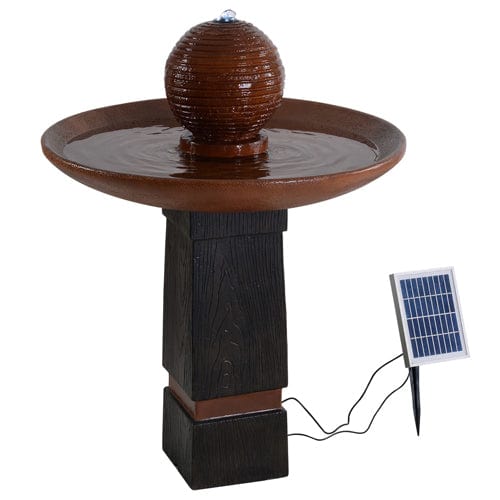Solar-powered outdoor water fountains represent a harmonious blend of technology and nature, offering a sustainable and aesthetically pleasing addition to gardens, parks, and outdoor spaces. This article delves into the workings of these fountains, explaining their components and operation.
Harnessing the Sun's Energy
The core technology behind solar-powered fountains is the photovoltaic (PV) cell. These cells convert sunlight into electricity through the photovoltaic effect. Solar panels, composed of multiple PV cells, capture sunlight and produce direct current (DC) electricity.
Components of a Solar Fountain
A typical solar fountain comprises a solar panel, a pump, and often a battery for energy storage. The solar panel is the most visible component, usually positioned to receive maximum sunlight. The pump, submerged in water, is responsible for circulating water through the fountain. In systems with a battery, energy collected during sunny periods is stored for use when sunlight is unavailable.
Solar Panels: The Power Source
The heart of a solar-powered fountain is its solar panel. These panels contain photovoltaic cells, which convert sunlight into electricity. The efficiency of these panels plays a crucial role in the fountain’s performance, especially in regions with varying sunlight conditions.
Solar panels in these fountains come in two main types: integrated and separate. Integrated panels are built into the fountain, offering a seamless design but less flexibility in positioning. Separate panels, on the other hand, are connected via a cable, allowing for optimal placement to maximize sun exposure.
Pump System: Circulating Water
At the core of the fountain's functionality is the pump, which circulates water through the fountain. When the solar panel generates electricity, it powers the pump. This pump then draws water from the basin and propels it through the fountain's structure, creating the desired water flow and patterns.
Solar-powered pumps vary in power and size, influencing the fountain's water flow rate. Higher-powered pumps can support more elaborate fountains with intricate water features, while smaller pumps are suitable for simpler designs.
Optional Battery Storage: Consistent Operation
Some solar-powered fountains include a battery backup system. This addition is particularly useful in maintaining fountain operations during cloudy conditions or at night. The battery stores excess energy produced during sunny periods, providing a continuous power supply to the pump when direct sunlight isn't available.
Operation of Solar-Powered Fountains
Converting Sunlight to Water Flow
When sunlight hits the solar panel, it generates electricity that powers the pump. This pump then draws water from the fountain's basin and pushes it through the fountain's spout or over its decorative features. The intensity of the water flow depends on the strength of sunlight and the efficiency of the PV cells and pump.
Direct and Stored Energy Systems
Solar fountains operate in two primary modes: direct and stored energy. In direct systems, the fountain functions only when there is sufficient sunlight. In contrast, fountains with battery storage can operate during overcast conditions or at night, using the energy accumulated during sunny periods.
Conclusion
Outdoor fountains can add a whole new element of visual interest to your space. Solar-powered outdoor water fountains provide an efficient and environmentally friendly way to create a peaceful ambiance in your patio. By harnessing the sun's energy, these fountains offer a sustainable solution, blending seamlessly with the natural environment. Their ease of installation, low operating costs, and minimal maintenance needs make them an attractive option for both private and public spaces. As solar technology continues to advance, these fountains will likely become even more efficient and versatile, further promoting the integration of green technology into our everyday lives.

